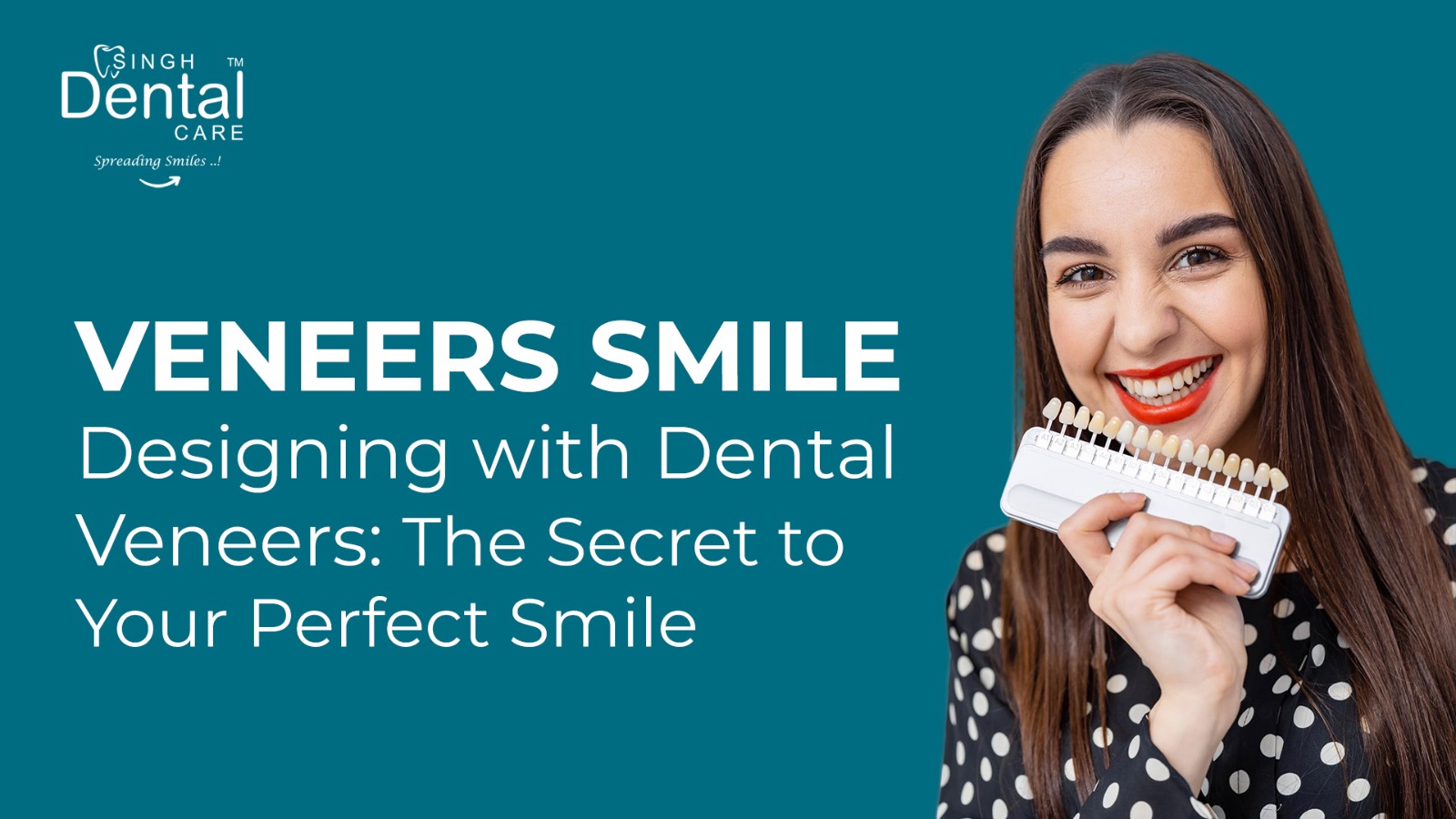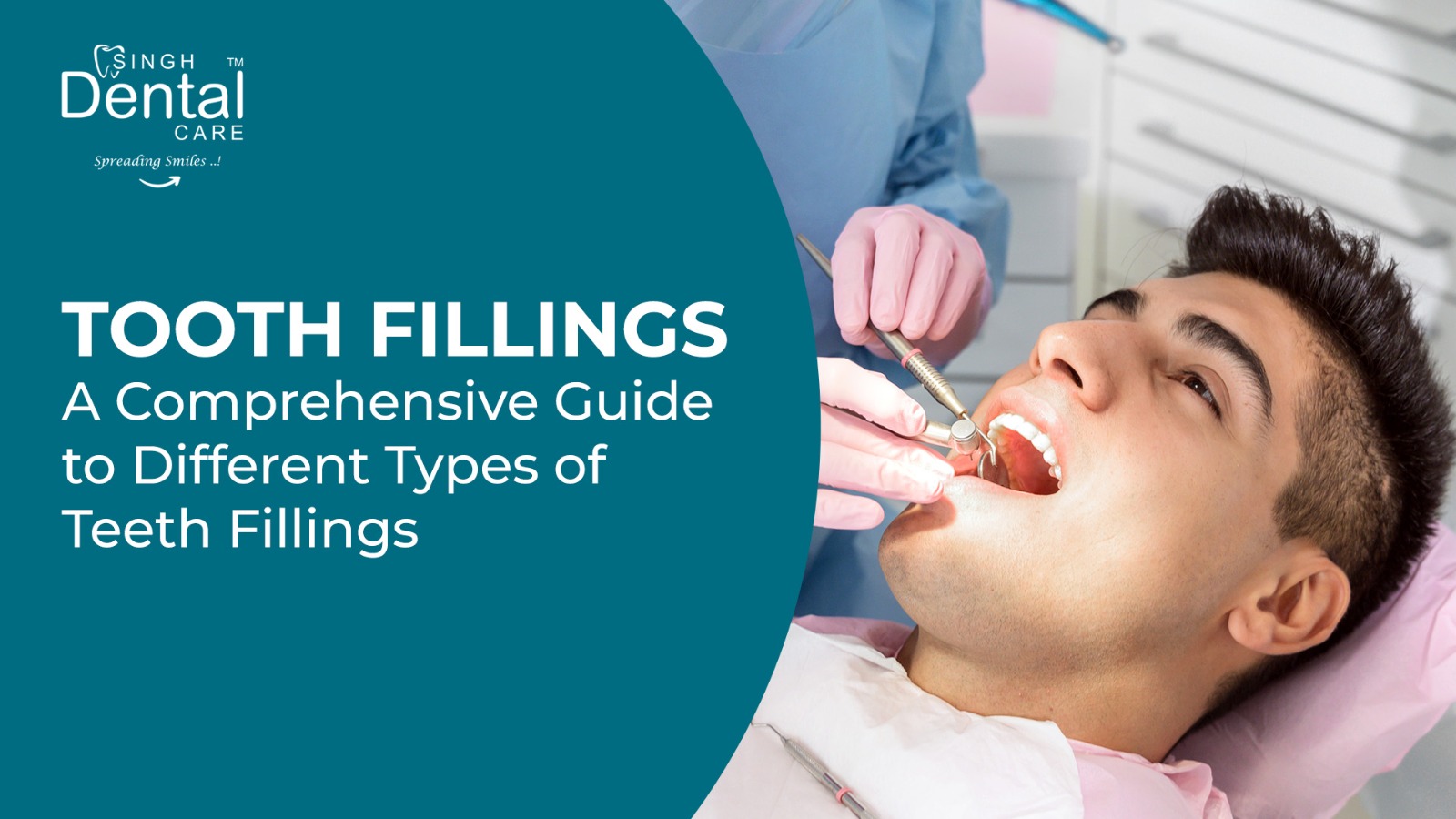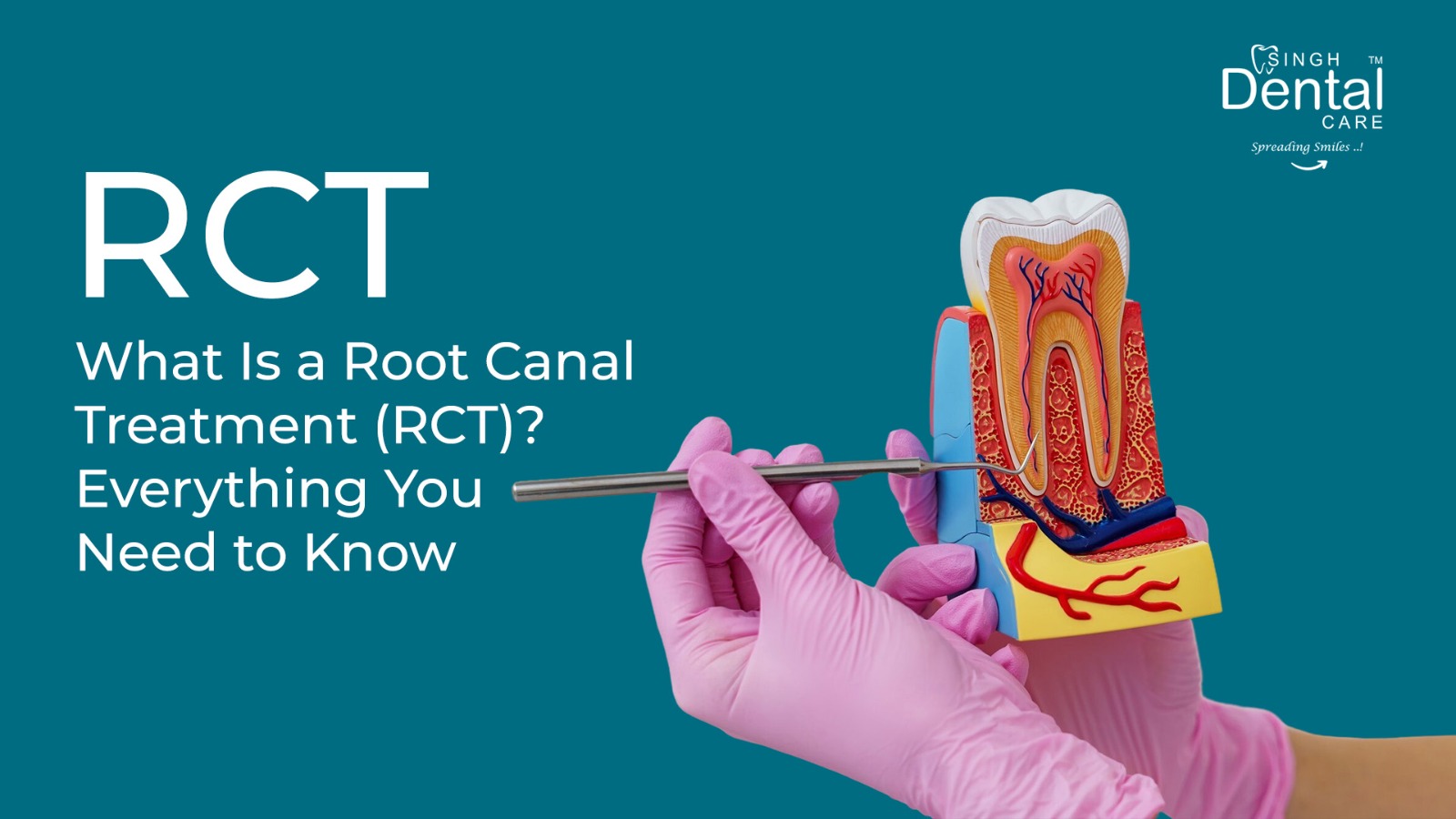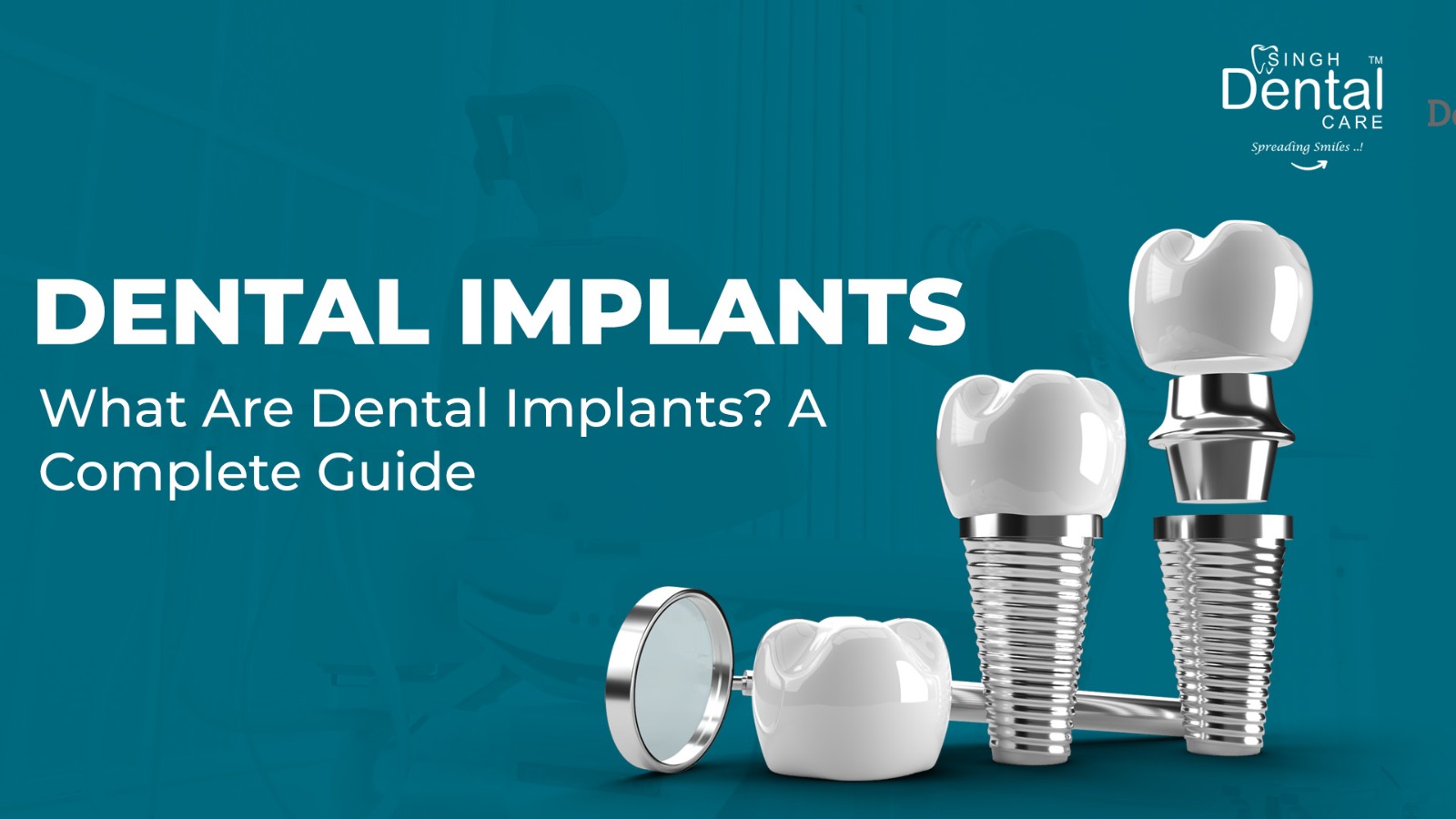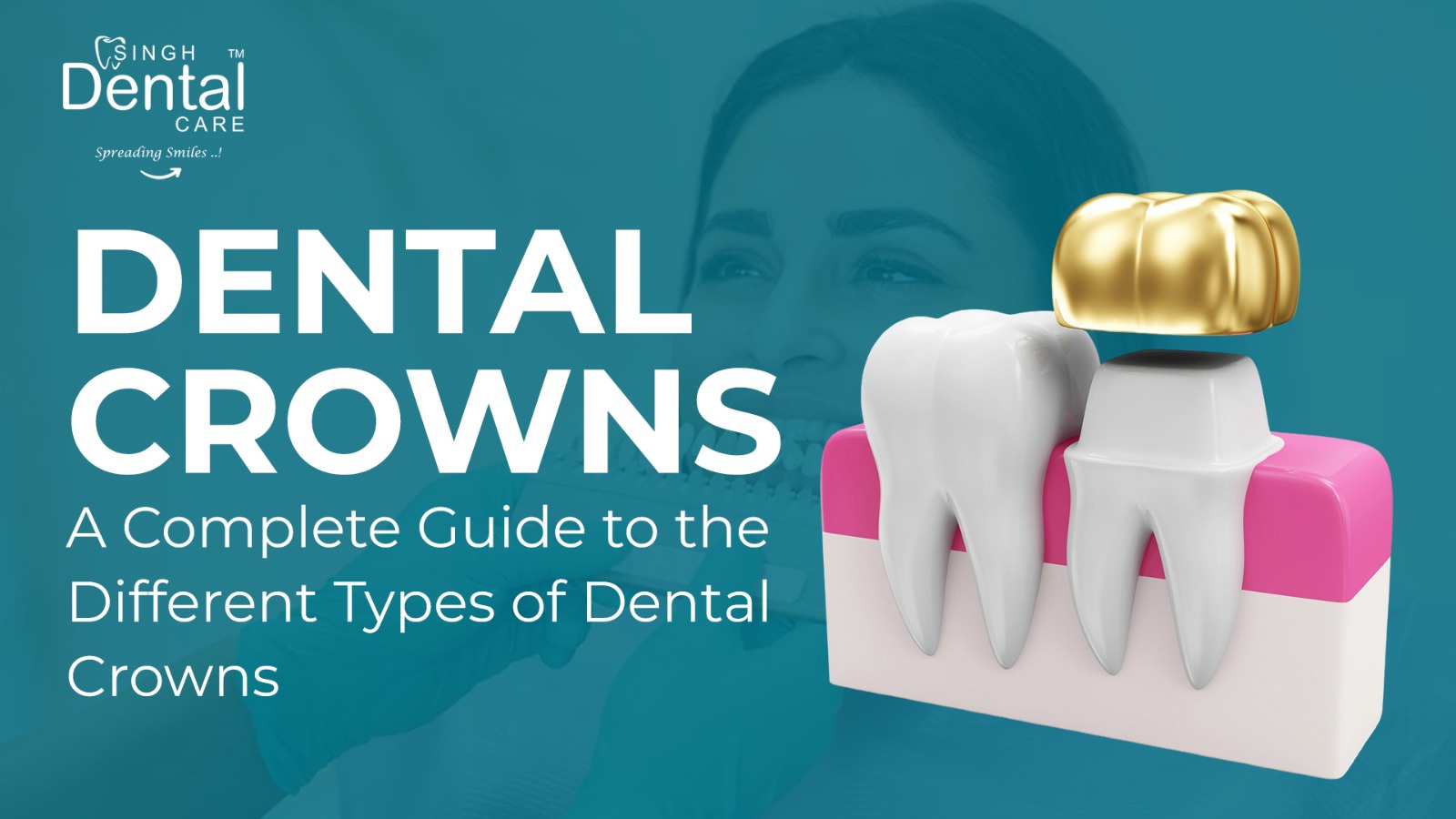VeneersSmile Designing with Dental Veneers: The Secret to Your Perfect Smile April 4, 2025 A beautiful, confident smile is one of the first things people notice about you. Whether you have crooked, stained, chipped, or uneven teeth, smile designing with dental veneers can help transform your smile into one that you’re proud to show off. If you’re considering cosmetic dentistry to enhance your smile, dental veneers could be the perfect solution. In this blog, we’ll explore how smile designing with dental veneers works, the benefits of veneers, and how they can help you achieve the smile of your dreams. What is Smile Designing? Smile designing is a comprehensive cosmetic dental treatment that focuses on enhancing the aesthetics of your smile. It involves improving the alignment, shape, size, and color of your teeth to create a more harmonious and attractive smile. While smile designing can involve several treatments like teeth whitening, bonding, and orthodontics, dental veneers are often the primary tool used in the process. Veneers can dramatically improve the appearance of your teeth by correcting imperfections such as: • Discoloration • Chips and cracks • Gaps between teeth • Misshapen or uneven teeth • Crooked teeth With smile designing, your dentist customizes a treatment plan that addresses your unique dental needs, and veneers are designed to enhance the overall appearance of your smile. What Are Dental Veneers? Dental veneers are thin, custom-made shells of porcelain or composite resin that are bonded to the front surface of your teeth. These veneers are designed to cover imperfections, giving you a smoother, more even smile. They are often used in smile designing to improve the aesthetics of your front teeth, which are most visible when you smile. There are two main types of dental veneers: 1. Porcelain Veneers: Made from high-quality ceramic, porcelain veneers are durable, natural-looking, and resistant to staining. They offer the best aesthetic results and are ideal for smile designing. 2. Composite Resin Veneers: Made from a tooth-colored resin material, composite veneers are a more affordable option. They can be applied in a single visit and are moldable to match the natural shape of your teeth. How Does Smile Designing with Dental Veneers Work? The process of smile designing with dental veneers typically involves several steps. Here’s what you can expect during your treatment: 1. Consultation and Smile Assessment The first step in smile designing is a consultation with your dentist. During this visit, your dentist will evaluate your teeth, discuss your aesthetic goals, and determine whether veneers are the right solution for you. They may take digital X-rays and impressions to create a detailed plan for your smile makeover. You may also discuss aspects like: • The shade of veneers to match your natural teeth or achieve a brighter, whiter smile. • The shape and size of your teeth to enhance your facial features and create balance. • Any specific concerns or desired outcomes, such as closing gaps or improving symmetry. 2. Creating Custom Veneers Once your treatment plan is finalized, the next step is creating custom veneers. If you’re getting porcelain veneers, your dentist will take impressions of your teeth, which will be sent to a dental laboratory. The lab will craft your veneers to the exact shape, color, and size needed to complement your smile. If you’re opting for composite veneers, they can often be sculpted directly onto your teeth during a single visit, though some shaping and polishing may be done over several appointments. 3. Preparation of Your Teeth To prepare your teeth for veneers, a small amount of enamel (usually less than a millimeter) is removed from the front surface of your teeth. This ensures that the veneers fit properly and align with the natural contours of your smile. For porcelain veneers, a temporary set of veneers may be placed while your custom veneers are being made. 4. Bonding the Veneers Once your veneers are ready, your dentist will carefully place them on your teeth to ensure a perfect fit. They will make any final adjustments, including shaping and polishing, to achieve the best possible look. Once satisfied, the veneers are bonded to your teeth using a special dental adhesive, and a curing light is used to harden the bond. 5. Final Adjustments After the veneers are securely bonded, your dentist will check your bite to ensure that everything feels comfortable. Any final adjustments will be made to ensure that your new smile is both aesthetically pleasing and functional. Benefits of Smile Designing with Dental Veneers There are numerous reasons why dental veneers are a popular choice for smile design. Some of the key benefits include: 1. Aesthetically Pleasing Results Veneers are one of the most effective ways to achieve a flawless smile. They are designed to match the natural color, shape, and size of your teeth, providing a seamless and natural-looking result. Whether you’re correcting discoloration, chips, or gaps, veneers offer an immediate transformation. 2. Quick and Minimally Invasive Unlike traditional orthodontic treatments or full-mouth restorations, dental veneers offer a quicker solution for improving the appearance of your smile. Most veneer treatments take only two to three visits, with minimal tooth preparation required. The process is also relatively non-invasive compared to other cosmetic procedures. 3. Durability Porcelain veneers are highly durable and resistant to staining. With proper care, they can last 10-15 years or more. This makes them a long-term investment in the aesthetics and health of your smile. 4. Customizable Veneers are highly customizable. Your dentist can design veneers to suit your specific needs and desires, from adjusting the shade to correcting imperfections. Whether you want a subtle enhancement or a dramatic makeover, veneers can be tailored to create your ideal smile. 5. Minimally Disruptive to Your Natural Teeth Veneers only require a small amount of enamel to be removed, preserving most of your natural tooth structure. This makes veneers a less invasive option compared to other dental procedures like crowns or full-coverage restorations. Who Is a Candidate
Tooth fillings : A Comprehensive Guide to Different Types of Teeth Fillings
Tooth fillings : A Comprehensive Guide to Different Types of Teeth Fillings April 4, 2025 https://youtu.be/623e-a9euAA?si=ZqG53A9nY6GcruSr If you’ve ever had a cavity, you know that fillings are the go-to solution to restore your tooth’s function and appearance. Dental fillings not only help repair damage caused by decay but also prevent further damage and restore the strength of the tooth. With advances in dental technology, there are several types of fillings available today, each offering different benefits depending on your needs, preferences, and budget. In this blog, we’ll explore the most common types of teeth fillings, how they work, their pros and cons, and how to decide which one might be right for you. 1. Amalgam Fillings (Silver Fillings) What Are They? Amalgam fillings are made from a mixture of metals, including silver, mercury, tin, and copper. These durable and affordable fillings have been used in dentistry for over 150 years. Pros: • Durable and Long-Lasting: Amalgam fillings are known for their strength and longevity, often lasting 10-15 years or longer with proper care. • Cost-Effective: They are one of the most affordable filling options. • Resistant to Wear and Tear: Amalgam fillings are highly resistant to pressure from chewing, making them ideal for back teeth where the force from biting and grinding is greatest. Cons: • Aesthetic Concerns: Amalgam fillings are dark in color, which makes them highly visible, especially in the front of the mouth. This can be a concern for people who want a more natural appearance. • Mercury Content: Though the mercury in amalgam fillings is considered safe by the FDA and other health organizations, some people prefer to avoid mercury-containing products due to health concerns. • Potential for Expansion: Over time, amalgam fillings may expand or contract due to temperature changes, which could cause the tooth to crack. Best For: Amalgam fillings are typically used for molars and premolars, where the filling isn’t as visible and durability is more important than aesthetics. 2. Composite Fillings (Tooth-Colored Fillings) What Are They? Composite fillings are made from a mixture of plastic resins and glass or quartz fillers, which allow them to blend seamlessly with your natural tooth color. These fillings are molded directly into the cavity and hardened with a special light. Pros: • Aesthetic Appeal: Composite fillings are designed to match the natural color of your teeth, making them ideal for front teeth or visible areas. • Versatility: These fillings can be used for cavities of any size and in almost any area of the mouth. • Bonding to Tooth Structure: Composite fillings chemically bond to the tooth, which provides additional strength and stability to the tooth structure. Cons: • Less Durable Than Amalgam: While composite fillings are strong, they are generally less durable than amalgam and may wear down or stain over time, especially in areas that undergo heavy chewing pressure. • Cost: Composite fillings tend to be more expensive than amalgam fillings. • Longer Procedure Time: The application of composite fillings requires more time, as the dentist must carefully layer the material and cure it in stages. Best For: Composite fillings are excellent for front teeth or any area where appearance is important. They are also suitable for small to medium cavities. 3. Ceramic Fillings (Porcelain Fillings) What Are They? Ceramic fillings are made from porcelain, which offers a highly durable and natural-looking solution for cavities. They are typically crafted in a dental laboratory and then bonded to the tooth in a later appointment. Pros: • Natural Look: Porcelain fillings are highly aesthetic and can be matched to the exact shade of your teeth, making them ideal for visible teeth. • Stain-Resistant: Ceramic fillings are resistant to staining and discoloration, so they maintain their appearance over time. • Durable: Porcelain is a very strong material, making it highly durable, and it’s more resistant to wear than composite fillings. Cons: • Cost: Ceramic fillings are among the most expensive options, due to the need for custom fabrication and the high-quality materials used. • More Tooth Removal: To fit ceramic fillings, your dentist may need to remove more of your tooth structure compared to other filling types. • Brittleness: While strong, ceramic fillings can be more brittle than other materials, and may crack or fracture under extreme pressure, especially if not properly placed. Best For: Ceramic fillings are ideal for front teeth and visible areas of the mouth. They are particularly popular for patients who want both aesthetics and durability. 4. Gold Fillings What Are They? Gold fillings are made from a mixture of gold, copper, and other metals. Like ceramic fillings, gold fillings are created in a lab and then placed in the cavity. Pros: • Durability: Gold fillings are extremely durable and can last 15-20 years or more, making them one of the longest-lasting filling materials. • Biocompatibility: Gold is well-tolerated by the body and rarely causes allergic reactions. • Wear Resistance: Gold fillings resist wear and tear very well, and they are less likely to expand or contract than amalgam. Cons: • Aesthetic Concerns: Gold fillings are highly visible, which may be a problem for people who want a more natural-looking filling, especially for front teeth. • Cost: Gold fillings are one of the most expensive types of fillings due to the material and the labor-intensive process of fabrication. • Longer Procedure: It usually requires two visits—one for creating an impression of the tooth and another for placing the final gold filling. Best For: Gold fillings are best suited for back teeth (molars), where aesthetics are less of a concern, and where durability is especially important. 5. Glass Ionomer Fillings What Are They? Glass ionomer fillings are made from a mixture of glass and acrylic materials. They are commonly used for fillings in cavities below the gum line or for baby teeth. Pros: • Release Fluoride: One of the unique benefits of glass ionomer fillings is that they release fluoride, which helps to protect the tooth from further decay. • Good for Temporary Use: Glass ionomer is often used as a temporary
Rct : What Is a Root Canal Treatment (RCT)? Everything You Need to Know
Rct : What Is a Root Canal Treatment (RCT)? Everything You Need to Know April 4, 2025 Root Canal Treatment, or RCT, is a procedure in which the infected or damaged pulp (the soft tissue inside your tooth) is removed, cleaned, and sealed. The pulp contains nerves, blood vessels, and connective tissue, and when it becomes infected or inflamed—usually due to deep cavities, cracks, or trauma—it can lead to significant pain, swelling, and other complications. RCT eliminates this infection, relieves pain, and preserves the tooth. When Is Root Canal Treatment Necessary? Root canal treatment is typically recommended when the pulp inside a tooth becomes infected or inflamed, which can happen due to: • Severe tooth decay: Deep cavities can expose the pulp to bacteria, causing infection. • Trauma or injury: A cracked or broken tooth can allow bacteria to enter and infect the pulp. • Repeated dental procedures: Multiple fillings or procedures can weaken the tooth and cause pulp damage. • Gum disease: Advanced gum disease can also affect the health of the tooth’s pulp. Signs that you might need a root canal include: • Persistent or severe toothache, especially when chewing or applying pressure • Sensitivity to hot or cold that lingers after the stimulus is removed • Swelling and tenderness in the gums near the affected tooth • Darkening or discoloration of the tooth • A pimple-like bump on the gums near the affected tooth (which may drain pus) The Root Canal Procedure: Step-by-Step Root canal therapy is typically completed in one or two visits to your dentist or endodontist (a specialist in root canal procedures). Here’s what you can expect during the process: 1. Initial Consultation and X-rays: Before starting the procedure, your dentist will take X-rays to assess the extent of the infection and examine the root canals of the affected tooth. 2. Local Anesthesia: To ensure comfort, the area around the tooth will be numbed with a local anesthetic. You may feel some pressure during the procedure, but you should not feel pain. 3. Accessing the Pulp: Your dentist will create a small opening in the crown (top) of the tooth to access the pulp chamber and root canals. 4. Cleaning and Shaping the Canals: The infected or damaged pulp is carefully removed, and the canals are cleaned and shaped to ensure they’re free of infection and prepared for filling. 5. Filling the Canals: Once the canals are cleaned and shaped, they are filled with a biocompatible material called gutta-percha. This seals the canals and prevents bacteria from re-entering. 6. Sealing the Tooth: After the root canals are filled, the tooth is sealed with a temporary or permanent filling. If the tooth had significant damage, your dentist may recommend placing a crown to restore its strength and function. 7. Follow-up Visit: In some cases, a follow-up visit may be necessary to place the permanent crown or make any adjustments. Your dentist will monitor the tooth’s healing process to ensure the treatment was successful. Is Root Canal Treatment Painful? One of the biggest misconceptions about root canal treatment is that it’s painful. In reality, the procedure is usually done under local anesthesia, so you shouldn’t experience pain during the treatment. Any discomfort or mild pain you feel afterward is typically temporary and can be managed with over-the-counter pain relievers. In fact, most patients report that the pain from the procedure is far less than the pain caused by the tooth infection itself, which can be severe. Benefits of Root Canal Treatment • Saves Your Natural Tooth: One of the main benefits of RCT is that it allows you to keep your natural tooth, avoiding the need for extraction. • Prevents Further Infection: By removing the infected pulp and sealing the tooth, root canal therapy prevents the infection from spreading to nearby teeth and gums. • Pain Relief: RCT can relieve the constant pain caused by infected tooth pulp, allowing you to return to normal activities without discomfort. • Long-Term Success: With proper care, treated teeth can last a lifetime. The success rate of root canal therapy is very high—typically around 95%. • Restores Function: After the procedure, the tooth can function like a normal tooth, allowing you to chew and speak without issues. Aftercare and Recovery After your root canal procedure, it’s important to follow your dentist’s instructions for post-treatment care: • Avoid chewing on the treated tooth until it’s fully restored (if a crown is needed). • Take prescribed medications (if any) to manage pain or inflammation. • Maintain good oral hygiene: Brush and floss regularly to keep the treated area clean and free of infection. • Schedule follow-up visits: Your dentist will monitor the treated tooth to ensure it heals properly. Alternatives to Root Canal Treatment In some cases, when root canal treatment isn’t possible or preferred, tooth extraction may be recommended. However, tooth extraction is usually a last resort, as it can lead to other complications such as shifting of surrounding teeth, bone loss, and the need for a dental implant or bridge to replace the lost tooth. Myths and Misconceptions About Root Canal Treatment • Myth 1: Root canals are extremely painful. • Truth: Most patients experience little to no pain during the procedure, and the discomfort afterward is generally mild and temporary. • Myth 2: A root canal will make your tooth brittle and weak. • Truth: While the pulp is removed during a root canal, the tooth itself remains strong. If a crown is placed afterward, it restores the tooth’s strength and function. • Myth 3: Root canals are unsuccessful. • Truth: Root canal treatment has a high success rate, with most teeth lasting for many years or even a lifetime when properly cared for. Conclusion Root Canal Treatment is a safe, effective procedure that can save your tooth and eliminate pain caused by infection or damage. If you’re experiencing severe tooth pain, sensitivity, or swelling, it’s important to see your dentist
Dental Implants: What Are Dental Implants? A Complete Guide
Dental Implants: What Are Dental Implants? A Complete Guide November 27, 2024 Dental implants are one of the most effective and long-lasting solutions for replacing missing teeth. They provide a strong, natural-looking foundation for crowns, bridges, or dentures, restoring both function and appearance to your smile. If you’re considering dental implants, here’s everything you need to know about this innovative and transformative dental procedure. What Is a Dental Implant? A dental implant is an artificial tooth root made of biocompatible materials, typically titanium, that is surgically placed into the jawbone. Once the implant fuses with the bone through a process called **osseointegration**, it acts as a sturdy foundation for attaching a replacement tooth or prosthetic. The Components of a Dental Implant 1. Implant Post The titanium screw-like post that is placed into the jawbone. It replaces the root of a missing tooth. 2. Abutment The connector piece that links the implant post to the replacement tooth or crown. 3. Crown The visible, natural-looking tooth that sits atop the abutment. Crowns are custom-designed to match the color, shape, and size of your natural teeth. How Do Dental Implants Work? The dental implant process involves several stages: 1. Initial Consultation: Your dentist will assess your oral health and take X-rays or scans to determine if you’re a good candidate for implants. Ideal candidates have healthy gums and enough bone density to support the implant. 2. Surgical Placement The implant post is placed into the jawbone during a surgical procedure, typically under local anesthesia. Afterward, there is a healing period (usually 3–6 months) during which the implant fuses with the bone. 3. Abutment and Crown Placement Once the implant has integrated with the bone, your dentist will attach an abutment to the implant, followed by a custom-made crown. This restores the appearance and function of your tooth. Benefits of Dental Implants 1. Natural Appearance Dental implants closely mimic natural teeth, both in form and function. They are designed to blend seamlessly with your smile. 2. Improved Functionality Unlike dentures, which can slip or shift, implants provide a permanent and stable solution. You can eat, speak, and smile confidently, without worrying about your teeth moving. 3. Long-Lasting Solution With proper care, dental implants can last a lifetime. This makes them a highly durable and cost-effective choice in the long run. 4. Preservation of Bone Health Since implants integrate with the jawbone, they help prevent bone loss that can occur when a tooth is missing. This helps maintain the structure of your face and prevents further dental issues. 5. Comfort and Convenience Implants eliminate the discomfort and inconvenience of removable dentures. You don’t have to worry about adhesives or adjustments. Are You a Candidate for Dental Implants? Dental implants are suitable for most people who have one or more missing teeth. However, certain factors such as inadequate bone density, gum disease, or overall health issues may affect candidacy. Your dentist will assess your individual case and determine if implants are the right option for you. Potential Risks and Considerations While dental implants are generally safe and effective, as with any surgical procedure, there are some potential risks, including infection, implant failure, or injury to surrounding tissues. It’s important to follow post-surgical care instructions carefully and attend regular checkups to ensure the implant heals properly. The Cost of Dental Implants The cost of dental implants can vary depending on factors such as the number of implants required, the complexity of the procedure, and your location. While implants may have a higher upfront cost compared to other tooth replacement options like dentures or bridges, they offer long-term value due to their durability and functionality. Conclusion Dental implants are a revolutionary solution for people looking to restore their smile and regain full dental function. With their natural appearance, strength, and long-lasting benefits, they offer an excellent alternative to traditional dentures or bridges. If you are missing one or more teeth and want a permanent solution, consider consulting with your dentist to see if dental implants are the right choice for you. Whether you’re seeking to improve your smile, enhance your chewing ability, or maintain your oral health, dental implants can provide the foundation for a better, more confident you. ### Frequently Asked Questions (FAQs) About Dental Implants If you’re considering dental implants, you likely have many questions about the procedure, recovery, and long-term benefits. Here are answers to some of the most common questions patients ask about dental implants. 1. What are dental implants? Dental implants are artificial tooth roots, typically made from titanium, that are surgically placed into the jawbone. They provide a stable foundation for attaching a replacement tooth or prosthetic, such as a crown, bridge, or denture. 2. Who is a good candidate for dental implants? Most healthy adults with one or more missing teeth are good candidates for dental implants. Ideal candidates have healthy gums, sufficient bone density in the jaw to support the implant, and are free of conditions such as uncontrolled diabetes or active gum disease. Your dentist will assess your overall health and oral condition to determine if implants are the right option for you. 3. What are the advantages of dental implants over dentures or bridges? Dental implants offer several advantages, including: 4. What does the dental implant procedure involve? The dental implant procedure typically includes three main stages: 1. Implant Placement The titanium post is surgically placed into your jawbone. This is done under local anaesthesia, and the healing period typically lasts 3-6 months as the implant fuses with the bone. 2. Abutment Placement Once the implant has integrated with the bone, an abutment is attached to the implant to hold the replacement tooth in place. 3. Crown Placement A custom-made crown is placed on top of the abutment, completing the restoration. 5. How long does it take for dental implants to heal? The healing time can vary depending on factors such as the number of implants placed and individual healing abilities. Generally, it takes **3
Dental Crowns : A Complete Guide to the Different Types of Dental Crowns
Dental Crowns : A Complete Guide to the Different Types of Dental Crowns November 28, 2024 most common solutions in restorative dentistry, designed to restore the shape, size, strength, and appearance of a damaged tooth. Crowns are often used when a tooth is too damaged for a filling but not damaged enough to require extraction. They can be made from a variety of materials, each offering distinct benefits depending on your needs and preferences. In this blog, we’ll explore the different types of dental crowns available, their advantages, and how to choose the best option for you. What is a Dental Crown? A dental crown is a cap placed over a tooth to restore its shape, size, and function. It completely covers the visible portion of a tooth above the gum line. Crowns are used for various purposes, including: • Restoring a broken or damaged tooth • Covering a large filling or cavity • Protecting a weakened tooth • Holding a dental bridge in place • Improving the appearance of a discolored or misshapen tooth There are several types of crowns available, each suited to different dental needs. Here’s a breakdown of the most common types of dental crowns: 1. Porcelain Crowns (All-Ceramic Crowns) What Are They? Porcelain crowns are made entirely from ceramic materials. They are known for their excellent aesthetic qualities, making them a popular choice for front teeth or any visible areas. Pros: • Natural Appearance: Porcelain crowns are highly aesthetic and can be color-matched to your natural teeth, making them almost indistinguishable from real teeth. • Biocompatible: Porcelain is a non-reactive material, making it ideal for patients with metal allergies or sensitivities. • No Metal Exposure: These crowns don’t have any metal base, which avoids the potential for a visible metal line at the gum line, a common concern with metal-based crowns. Cons: • Less Durable Than Metal: While porcelain is strong, it is more prone to chipping or cracking compared to metal crowns, especially in areas that experience heavy chewing pressure. • More Expensive: Porcelain crowns tend to be pricier than metal or porcelain-fused-to-metal crowns. Best For: Porcelain crowns are ideal for front teeth or other highly visible areas where appearance is a priority. They are also suitable for people with metal sensitivities. 2. Porcelain-Fused-to-Metal (PFM) Crowns What Are They? Porcelain-fused-to-metal crowns combine the strength of a metal crown with the aesthetic qualities of porcelain. The interior of the crown is made of metal, while the outer layer is porcelain, providing a natural look. Pros: • Strong and Durable: The metal base provides strength, making PFM crowns more durable than all-porcelain crowns, especially for back teeth that endure a lot of chewing pressure. • Natural Look: The porcelain layer can be color-matched to blend with the natural teeth, offering a more aesthetic result than full metal crowns. • Long-Lasting: PFM crowns are very durable and can last for 10-15 years with proper care. Cons: • Visible Metal Line: Over time, the metal base may show at the gum line, which can be a concern for people with gum recession or those who are looking for a crown that looks completely natural. • More Invasive: To fit a PFM crown, your dentist may need to remove more of the natural tooth structure than with other materials. Best For: PFM crowns are suitable for back teeth where durability is important, and they can also be used for front teeth when aesthetics are important but the crown needs to withstand more chewing force. 3. Metal Crowns (Gold or Other Alloys) What Are They? Metal crowns are made from a variety of metal alloys, including gold, platinum, or non-precious metals like nickel-chromium. These crowns are known for their durability and strength. Pros: • Highly Durable: Metal crowns are the most durable option, lasting 15-20 years or more. They are resistant to wear and won’t crack under heavy biting forces. • Ideal for Back Teeth: Their strength makes them ideal for molars and premolars, which endure the most pressure while chewing. • Minimal Tooth Removal: Because metal crowns are thinner than porcelain crowns, less natural tooth structure needs to be removed during the preparation process. • Biocompatible: Gold and other precious metals are highly biocompatible, making them safe for most people, including those with metal allergies. Cons: • Aesthetic Concerns: Metal crowns are very noticeable due to their metallic color. This makes them unsuitable for front teeth or visible areas where appearance matters. • Cost: Gold and platinum crowns are generally more expensive than porcelain or PFM crowns. Best For: Metal crowns are ideal for back teeth (molars and premolars), where durability is key, and aesthetics are less of a concern. 4. Zirconia Crowns What Are They? Zirconia crowns are made from a highly durable ceramic material called zirconium dioxide. These crowns combine the strength of metal with the aesthetic properties of porcelain. Pros: • Highly Durable: Zirconia crowns are incredibly strong and resistant to wear, making them ideal for back teeth that endure heavy chewing forces. • Aesthetic Appeal: Zirconia can be made to match the color of natural teeth, offering a more aesthetic result than metal crowns. • Biocompatible: Zirconia is well-tolerated by the body and is a good option for those with sensitivities to other metals. • Minimal Tooth Removal: Zirconia crowns require less tooth structure removal compared to metal crowns, making the procedure less invasive. Cons: • Potential for Wear on Opposing Teeth: Because zirconia is so hard, it can sometimes cause wear on the opposing teeth, particularly if they are made from porcelain. • Cost: Zirconia crowns tend to be more expensive than porcelain or metal options, though they can be more affordable than gold crowns. Best For: Zirconia crowns are an excellent choice for back teeth that need a durable, long-lasting solution while maintaining a natural appearance. 5. Resin Crowns What Are They? Resin crowns are made from a plastic material, often combined with composite resins to give them a tooth-like appearance. These crowns are typically used for temporary restorations. Pros:
Teeth Whitening : A Complete Guide to Teeth Whitening
Teeth Whitening : A Complete Guide to Teeth Whitening April 4, 2025 Achieving a Brighter Smile A bright, white smile can significantly boost your confidence and improve your overall appearance. Over time, however, factors like food, drinks, tobacco use, and even aging can cause teeth to become discolored or stained. Fortunately, modern dentistry offers several options for teeth whitening, allowing you to restore the natural brilliance of your smile. In this guide, we’ll take a look at what teeth whitening is, the different methods available, and how you can achieve a whiter smile that lasts. What Is Teeth Whitening? Teeth whitening is the process of lightening the color of your teeth by removing stains and discoloration. The most common causes of teeth discoloration include: • Foods and beverages: Coffee, tea, red wine, and dark-colored foods can stain your teeth over time. • Tobacco use: Smoking or chewing tobacco can cause yellow or brown stains. • Aging: As we age, the enamel on our teeth naturally wears down, revealing the yellower dentin underneath. • Poor oral hygiene: Inconsistent brushing and flossing can lead to plaque buildup and surface stains. • Medications: Certain medications, such as antibiotics like tetracycline, can cause discoloration in teeth. • Genetics: Some people naturally have more yellowish teeth due to their genetics. While you can’t always stop the natural aging process or avoid every stain-causing food, teeth whitening treatments can help reverse or reduce the appearance of discoloration, giving you a more radiant, youthful smile. Methods of Teeth Whitening There are several ways to whiten your teeth, ranging from over-the-counter products to professional treatments. The right option for you will depend on your budget, time, and the level of staining you’re dealing with. 1. Professional In-Office Teeth Whitening If you’re looking for fast, dramatic results, professional teeth whitening performed by your dentist is the best option. In-office treatments use stronger whitening agents than at-home products, and the process is monitored by a professional to ensure safety and effectiveness. How it works: • A whitening gel containing hydrogen peroxide or carbamide peroxide is applied to your teeth. • A special light or laser may be used to activate the whitening gel and speed up the process. • The treatment usually takes 60 to 90 minutes, with immediate results after just one session. Pros: • Fast results: A noticeably brighter smile in just one visit. • Safe and effective: The procedure is supervised by a dental professional to ensure maximum results with minimal sensitivity or damage. • Customized: The strength of the whitening treatment can be tailored to your needs. Cons: • Cost: In-office treatments are typically more expensive than at-home options. • Sensitivity: Some patients may experience temporary tooth sensitivity after the procedure. 2. At-Home Teeth Whitening Kits (Professional Grade) For those who prefer to whiten their teeth at home, many dentists offer take-home whitening kits. These kits typically involve custom-made trays that you fill with a whitening gel and wear for a specific period each day. They deliver results gradually over the course of several days or weeks. How it works: • Your dentist will take impressions of your teeth to create custom whitening trays that fit snugly over your teeth. • You apply a professional-strength whitening gel to the trays and wear them for a designated amount of time each day. • Depending on the product, results can take anywhere from a few days to a few weeks. Pros: • Custom-fitted trays ensure even whitening and comfort. • Professional-grade formula is more effective than over-the-counter options. • Convenient: You can whiten your teeth at home on your schedule. Cons: • Time-consuming: Takes longer to achieve results compared to in-office treatments. • Cost: Though less expensive than in-office whitening, these kits still cost more than over-the-counter products. 3. Over-the-Counter Teeth Whitening Products If you’re looking for a more affordable solution, there are several over-the-counter whitening products available. These products, such as whitening toothpaste, strips, gels, and trays, are easily accessible and relatively inexpensive. How it works: • Whitening toothpaste: Contains mild abrasives or chemicals that help remove surface stains. • Whitening strips: Thin plastic strips coated with a whitening gel that you apply directly to your teeth. They’re typically worn for 30 minutes to an hour each day. • Whitening pens: Apply a thin layer of whitening gel directly to your teeth for targeted treatment. Pros: • Affordable: Over-the-counter options are generally much cheaper than professional treatments. • Convenient: Easy to use at home with little effort. • Non-invasive: There’s no need for a dentist visit or special equipment. Cons: • Less effective: Over-the-counter products may not provide the same dramatic results as professional treatments. • Time-consuming: You may need to use these products over a longer period to see noticeable changes. • Possible tooth sensitivity: Some products can cause discomfort, especially if used excessively. 4. Natural Teeth Whitening Remedies Some people prefer natural remedies to whiten their teeth, using common household items. While these methods are not as scientifically proven as professional treatments, some people find them effective for minor staining. Common natural remedies: • Baking soda: A mild abrasive that can help remove surface stains. • Hydrogen peroxide: Often used as a mouthwash, hydrogen peroxide can have mild whitening effects when diluted with water. • Oil pulling: Swishing coconut oil around your mouth for 15-20 minutes is believed by some to help remove bacteria and surface stains. • Apple cider vinegar: It has a mild bleaching effect when diluted with water, but it’s acidic, so it should be used cautiously. Pros: • Inexpensive: These remedies are usually cheap or free. • Natural: Many people prefer to avoid chemicals and artificial ingredients. Cons: • Limited effectiveness: Natural remedies may not provide significant whitening, especially for deeper stains. • Potential damage: Some natural products (like vinegar) can erode enamel if used too frequently or improperly. How to Maintain Your Whiter Smile Once you’ve achieved your desired level of whiteness, it’s important to maintain your

